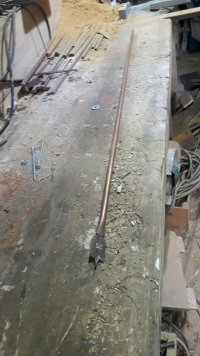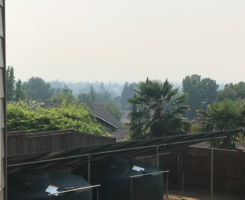Those are serious water tanks
What i would do with first one:
Discover the full Froth-Pak product range. Disposable tanks Froth-Pak 180 and Froth-Pak 600, but also the big refillable cylinders of the Froth-Pak 1900.

www.fomicom.com
I don't think they will ship to the US of A, price wise i dont even think you want that.
But i am very sure there is a simulair product over there.
Keep the next rules as basic rules:
Make sure your barrel is full and with a water temperature about 85F/30C
Make
absolutely sure that the foam your are going to apply can handle a heat of 230F/110C, some foams will not take higher temps as 190F/90c or even 165F/75C and will get brittle.
Practice on a sheet of wood, before starting to spray on one of your tanks
Most packs needs to be pre heated to 85F/30C, i use some simple electric dog blankets.
The rest will be a bit the same as Divid Poz:
View: https://www.youtube.com/watch?v=ryJmtItfaXQ
Instead of using copper coils from boilers for heat exchangers you could use those plastic floor heating tubes.
One coil for floor heating or radiator heating, your closed system.
And one coil connected to your drinking water supply.
Make your coil for drinking/shower water a 110 yard or so, so the water will have time enough to get the heat from the water.
Dig that one into the soil, it is big enough to heat up your house, shower, dishes...
All you need are some 48v water heating elements a small circulation pump(50-55 us gal/200 litres an hour is more than enough, give it time)
Some small regulation electronics with a small sensor, warmer than 190F/90C cut off the panels, below 190F open the panels.
Make sure all of your plumbings are isolated aswel to prevent extra heat loss.
Get pir sheet of 4 inches thick and a "flat" wood drill (speed drill?) extend with a copper/alu/steel pipe of 3-3.5 foot
Wedge the drill in it, pir does not need a lot of torck.

Cut the sheets in 4x4 inches length wise, drill a hole thru the middle, shove your pipe in it, next.....
Between the joints use insulation foam, i don't think you can get my favourite foam but any similar to "fm330 or fm350" will do its job perfect.
39kwh/day to heat my 2600sq ft house



My house is double the size and we use not even 9 kwh, if we start cooking we must open the windows.
Next to the amazing inventions is insulation.
If only there were only a way to do Hot-Water -> Electricity.
I would hesitate (not really btw)to do this, but as a experiment it would be very nice: create steam.
What i did for one of my school projects was a sheet of rockwoll in a wooden box of 20x40 inch and 10 inch high.
I put on top some copper pipe with a centre to centre distance of 4 to 6 inch and 1 inch above the rockwool.
2 inch higher i had nailed a epdm pond foil on it and cover the whole thing up with a glass sheet.
Connected to the water pipe and waiting 5 minutes, we could made very hot coffee.
Once i did the same experiment on my pond with a 28 sq ft sheet...the pump was a bit to weak to push a needed amount of water thru it, it was coming out boiling with full sun on it.
On a Saturday morning the pump was jammed with algae, pure steam was coming out.
Oke we are going to second base:
Heat up the steam more to get it more dry: 230-255F/110-125C equals ~12 to 16 bar of pressure(considered as hi pressure for in a steam loco!), now this would make a nice set up to run a steam cylinder to get a generate going (dont run off to get a big boy's or the AA20's cylinder equivalent)
Steam cylinders are pretty easy to make if you can handle a reamer and can do some silver soldering.
But be careful please, steam is not only very hot but also
incredibly strong, pay attention when your are going to make your valves and your connections.
Low pressure steam can do the same 212-230F/100-110c equals ~1-12 bar.
If they could do it in 1820-1840, then we can do it better
With the other two i would also dig them in for rain water harvest, one for the garden and one for washing machine (shower) and toilet.
Filter up to 130 micron with a small pump in it and some oxygen ball.
For drinking water you need a setup that would need more space, technology and measurements than your power wall, but yes it can be done.
Preferably a contentions system of 10 to 20 gal an hour, the exes water can be returned into the filter.
An on demand system, nope.
Both cases will also drain your wall faster than you can charge it, thinking of uv-c, ozon, hi pressure pump, filters.
You want to get some dirt, industrial pollution and bird droppings out.
Especially the droppings are making it expensive.
Yes i hear you think: what about the old days...
We did not have industrial pollution thus healthy bacteria that good do the job easy, less dirt in the air also.
If you want to get a ruf idea, google for koi pond filters for a starting set.
Btw lifting a bucket of that size....got any idea what structure you must have to support that amount of weight....
Sorry but the myth of the bricklayer and his bucket of bricks is playing in my mind now...up and down and here we go up again.
With best regards Igor












